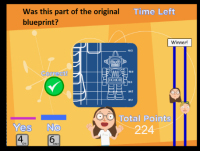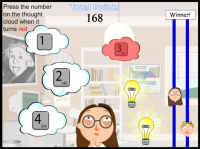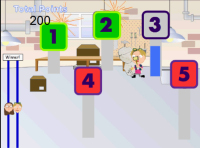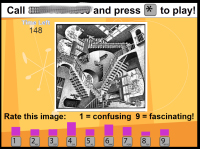Get in Line is a student pitched development project to create interactive experiences that can entertain people while they wait in long lines. Waiting in lines for events usually creates a disconnect from the ‘total guest experience’ and is often the number one complaint people have regarding their experiences with entertainment venues and activities. This project will develop a themed interactivity with a gameplay mechanic that captive line audiences can participate in.
More information can be found on the ETC project site .
 Role: Game Designer
Role: Game Designer
My responsibility on this project is to develop and interate on the gameplay mechanic that we use in our line activity.
Our final iteration used two lines who competed with one another in a series of mini games. The entire experience was paced with video interstitials, games, activities, instructional video elements, and break times.
Here is an overview of how our big end-of-semester prototype experience ran…
Our project partnered with Megaphone as the official platform for our prototype. With Megaphone, guests can dial a local phone number and once connected can interact with a large screen using their phone as a game controller. We created several mini-games for our experience.
Voting Games
 Several of our games used a very simple voting mechanic, where teams would vote on the correct answer and gain points. In the Memory game, the team was shown a large image at the beginning, then had to guess on smaller images and remember if they were part of the original or not. In another game, guests were shown a title, and had to guess whether it belonged to a past BVW World or a children’s book (since our prototype was for the line for the BVW show, we themed our experience with that in mind).
Several of our games used a very simple voting mechanic, where teams would vote on the correct answer and gain points. In the Memory game, the team was shown a large image at the beginning, then had to guess on smaller images and remember if they were part of the original or not. In another game, guests were shown a title, and had to guess whether it belonged to a past BVW World or a children’s book (since our prototype was for the line for the BVW show, we themed our experience with that in mind).
I toyed with the idea of giving partial credit for wrong answers depending on how many people did vote on the right one, but this was not intuitive and difficult to convey. This was an attempt to address the potential problem where a guest may consistently choose the right answer when his team votes on the wrong one, and may get frustrated that his vote is not having an impact. In the actual prototype test, this did not seem to arise as an issue.
Timed Button Pressing Games
 In these games, the guests had to hit a certain number on their keypad at a certain time. The more guests that hit the mark on one team, the faster that team would progress. In the Brainstorming game, guests had to hit the number on a thought cloud when it turned red, making it grow bigger and eventually turning into an idea. The first team who turned all its thought clouds into ideas won. In the Whack-a-Mole game, guests earned points for their team by hitting the number of the hole that the enemy popped out of (but lost points if they accidentally hit CMU’s mascot, Scotty the dog).
In these games, the guests had to hit a certain number on their keypad at a certain time. The more guests that hit the mark on one team, the faster that team would progress. In the Brainstorming game, guests had to hit the number on a thought cloud when it turned red, making it grow bigger and eventually turning into an idea. The first team who turned all its thought clouds into ideas won. In the Whack-a-Mole game, guests earned points for their team by hitting the number of the hole that the enemy popped out of (but lost points if they accidentally hit CMU’s mascot, Scotty the dog).
Button Mashing Game
 In this game, guests had to repeatedly hit the number displayed on a meter to fill the meter up. The team who filled up all of its meters first won the race. Originally, there was a big problem with the slight latency between a button press and receiving the signal from Megaphone’s server. After some adjustments, though, we got rid of the lag and the guests did not perceive any dropped signals in playtesting.
In this game, guests had to repeatedly hit the number displayed on a meter to fill the meter up. The team who filled up all of its meters first won the race. Originally, there was a big problem with the slight latency between a button press and receiving the signal from Megaphone’s server. After some adjustments, though, we got rid of the lag and the guests did not perceive any dropped signals in playtesting.
Activities
 In the early part of our line experience, we had non-scored activities where guests could practice and get used to the idea of calling in and using their phones to affect something on screen. The rating activity let you call in and rate an image from 1-9, and would show the average of how each team rated the image (the last activity had the guests rate the people in the opposing line).
In the early part of our line experience, we had non-scored activities where guests could practice and get used to the idea of calling in and using their phones to affect something on screen. The rating activity let you call in and rate an image from 1-9, and would show the average of how each team rated the image (the last activity had the guests rate the people in the opposing line).
![]() In the Avatar activity, guests would call in and see a dot with the last four digits of their phone number on screen. They could move the dot around with the border numbers on their keypad. We repeated this activity as a way for guests to log in to each game, and they really enjoyed the feedback of seeing that they were connected and that their avatar was responding to their phone.
In the Avatar activity, guests would call in and see a dot with the last four digits of their phone number on screen. They could move the dot around with the border numbers on their keypad. We repeated this activity as a way for guests to log in to each game, and they really enjoyed the feedback of seeing that they were connected and that their avatar was responding to their phone.